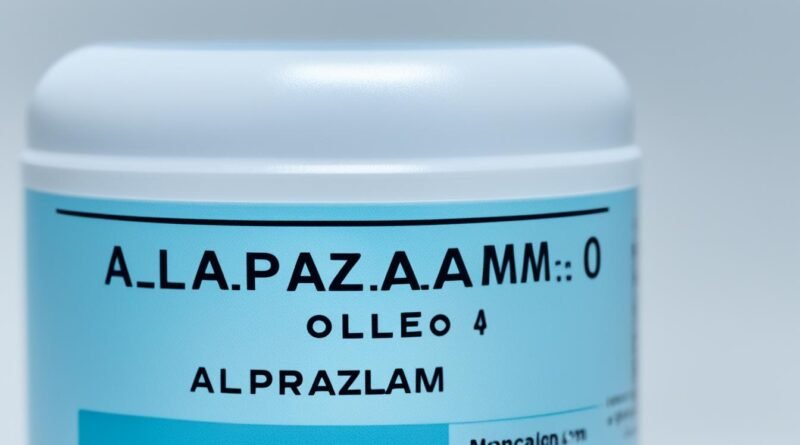Everything related to alprazolam
Alprazolam, commonly known as Xanax, is widely prescribed in the United States1. It’s part of a group called benzodiazepines, known for their calming effects on the brain and body2. Doctors mainly give it for anxiety problems, like general anxiety and panic attacks, sometimes with a fear of open spaces (agoraphobia)1. But, it’s also used in ways not approved by doctors, like seeking its pleasant, less fearful, and calming effects2. This guide covers everything important about alprazolam. You’ll learn about its uses, how it works, its side effects, and other essential info. This knowledge will keep you well-informed about this often-prescribed medication.
Indications for Alprazolam Use
Alprazolam is okayed by the FDA for treating anxiety disorders3. It’s also great for relieving anxiety symptoms in the short term3. The FDA says it’s specifically for folks with a lot of worries and those who have panic attacks and may be scared to leave their home (agoraphobia)34. Over the years, doctors have found it can help with issues like not being able to sleep, feeling down before your period, and depression35.
FDA-Approved Indications
- It’s good for people with too much anxiety, like when you’re always worried or when you have panic attacks35
- It’s also for panic attacks especially if they come with a fear of open or public places35
Off-Label Uses
- Doctors have found it can help with sleeping problems35
- It’s also used for severe bad moods before a woman’s monthly cycle35
- And for feeling very depressed35
Even though alprazolam mainly treats anxiety and panic, doctors have used it for other issues, too. This includes problems sleeping, mood changes before a period, and depression35. Just keep in mind, that the FDA hasn’t studied or given the thumbs up for these other uses of alprazolam.
Mechanism of Action
Alprazolam and other benzodiazepines work by attaching to specific spots in the brain. These spots are called the benzodiazepine receptor6. They affect the GABA-A receptor complex. This complex is a key regulator in our central nervous system (CNS)6.
When alprazolam binds to the GABA-A receptor, it boosts gamma-aminobutyric acid’s (GABA) action. This makes the nervous system calm down. It does this by increasing GABA’s attraction to the receptor. So, alprazolam helps with anxiety, sleep, and muscle tension6.
Using benzodiazepines for a long time can make the GABA-A receptor work less effectively. This might happen even after only a week’s use. Problems like sleepiness, forgetfulness, and coordination issues can occur. Also, using them can impact your feelings, hormones, heart rate, and blood pressure6.
There are different types of benzodiazepine receptors. Each has its effect. For instance, alpha 1 causes sleepiness, while alpha 2 reduces anxiety6. Z-drugs, which are non-benzodiazepines, help with sleep issues. They work quickly and don’t stay in your body for too long, usually just a few hours6. They work like benzodiazepines by attaching to the GABA-A receptor6.
Pharmacokinetics of Alprazolam
Alprazolam is a powerful medication known for how quickly our bodies absorb it when taken by mouth5. Within 1-2 hours, the blood levels of alprazolam peak5. The amount of the drug that gets into our bloodstream from the pill we take is about 84-91%5. Alprazolam mostly sticks to blood proteins, like albumin, meaning it has a high chance of being effective7.
The liver breaks down most of the alprazolam we take, thanks to a special enzyme called cytochrome P450 3A4 (CYP3A4)7. It turns into helpful byproducts, and all of these, including the original drug, mostly leave our bodies through urine. In healthy adults, alprazolam can last about 11.2 hours in their blood before it’s gone. But, in older people or those with liver issues due to alcohol, it might stay around a lot longer, up to nearly 20 hours5.
The way alprazolam moves through our bodies, from being absorbed quickly, to how it’s used and removed, affects how it works and why careful dosing is essential8. For example, the rate at which our bodies remove alprazolam is quite low, between 0.7 and 1.5 mL every minute for each kilogram we weigh5. After swallowing the pill, alprazolam tends to spread well throughout the body, filling 0.8 to 1.3 liters for each kilogram5.
Many things can change how alprazolam acts in our bodies, like mixing with other drugs or being used in people with specific health conditions7. If taken together with a drug that speeds up alprazolam’s removal process, like carbamazepine, the rate at which our bodies clear alprazolam might more than double5. Moreover, being overweight can also adjust how we handle alprazolam and another similar drug called triazolam8.
In conclusion, alprazolam’s journey through our bodies, from being absorbed fast, sticking to proteins, breaking down, and finally being removed, is key to its effects and the need to use it carefully785.
Administration and Dosing
Alprazolam, in medicines like XANAX®, comes in different oral dosage forms. It includes immediate-release tablets, extended-release tablets, and orally disintegrating tablets9. You might take the immediate-release ones two to four times daily. But, with the extended-release form, you only take it once daily.
The immediate-release and orally disintegrating forms come in 0.25 mg, 0.5 mg, 1 mg, and 2 mg strengths. The extended-release types are found in strengths of 0.5 mg, 1 mg, 2 mg, and 3 mg9. You can also get alprazolam as an oral solution. It comes in 0.5 mg/5 mL and 1 mg/10 mL strengths10.
Treatment of Anxiety Disorders
For anxiety disorders, adults usually start with 0.25 mg to 0.5 mg three times a day. You can adjust the dose slowly, every 3 to 4 days, not more than 1 mg extra each time. The highest daily dose should not go over 4 mg9. For older patients, start with 0.25 mg two or three times a day9.
Treatment of Panic Disorders
Panic disorders might need a bit more focus. Adults could begin the extended-release form with 0.5 mg to 1 mg daily. This may be raised up to 3 to 6 mg daily for the maintenance dose11. The highest daily dose is 10 mg10. With the immediate-release types, start with 0.5 mg three times daily10. For older adults, start with 0.5 mg daily for the extended-release kind and 0.25 mg two or three times daily with the immediate-release types10.
Dose Adjustments
They’re still studying the use of alprazolam in pediatric patients11. Need help with the liver or have a serious illness? Talk with your doctor. For these patients, the start might be 0.25 mg two or three times a day for the immediate-release or 0.5 mg daily for the extended-release type9.
Alprazolam is not great during pregnancy. There’s a registry to follow the outcomes for those who take it while pregnant10. It’s not good for breastfeeding either because it passes into the milk and can affect the baby10.

To sum up, alprazolam comes in several forms and strengths. It’s important to follow the right dose, especially for treating anxiety disorders and panic disorders. And, doctors may need to adjust the dose for some patients to make sure it’s safe and works well.
Alprazolam
Alprazolam is better known as Xanax. It’s a type of medicine called a benzodiazepine. The U.S. DEA calls it a controlled substance because of its risks12. There is a danger of misuse, addiction, and overdose with drugs like Xanax. So, doctors keep a close eye on people who take it. They make sure the benefits outweigh the risks.
Its main job is to help with anxiety and panic. It does this by affecting a chemical in the brain. This chemical helps to calm you down. But, be careful, mixing it with some meds or alcohol is risky. It can slow down breathing or even make you very sleepy12. Also, people can become used to it quickly and have a hard time stopping without help12.
This medication comes in different forms. You might find it as a tablet, a pill that dissolves in your mouth, or even a liquid. How often you take it depends on your doctor’s advice. If you’re older, your dose might be lower to avoid too many side effects12.
Sometimes, doctors use alprazolam to treat things not on the FDA’s list. These include depression, fear of open spaces, and symptoms around a woman’s period. But, they must make sure the good outweighs the bad before doing so12.
Feeling tired, dizzy or having a dry mouth are common when taking Xanax. Some serious effects like not breathing well or having seizures can also happen. It’s best to keep Xanax in a safe place, like a closed container, away from heat and humidity12.
Don’t share your Xanax with others. It can be harmful if used without a doctor’s okay. Always follow the directions on the label and let your doctor know if something doesn’t feel right13.
If you or someone you know has a bad reaction to Xanax, tell the FDA or Health Canada. In the U.S., call the FDA at 1-800-FDA-1088 or go online to www.fda.gov/medwatch14. In Canada, call Health Canada at 1-866-234-234514.
To wrap it up, Xanax is a powerful medicine that needs to be used carefully. It can be addictive and cause serious problems. Doctors and patients should team up to use it safely. Always watch out for any bad effects.
Adverse Effects and Precautions
Alprazolam is a common benzodiazepine with many potential side effects15. Users might feel sleepy, tired, or dizzy. They could have trouble sleeping or remembering things. Handling tasks, like walking or speaking, might become hard. Digestive issues are also possible, like stomach pain or vomiting16.
It can lead to more serious problems too, like slow breathing or low blood pressure. Sometimes, it can cause reactions opposite to what’s expected, such as more anxiety or being easily upset15.
Stopping alprazolam suddenly can create problems. This might include seizures, shaking, or feeling very anxious or sad. So, if someone needs to stop, it’s best to lower the dose bit by bit over time15. Older patients might face more difficulties. They could get very sleepy, dizzy, or find it hard to think straight15.
- It’s important to be careful if you have had troubles with drugs or alcohol, are often sad, or have had lung issues. This also applies if you have ever had a seizure15.
- If you have a kind of eye problem called narrow-angle glaucoma, alprazolam is not for you15.
- Avoid eating grapefruit or drinking its juice while on alprazolam. It can make things worse15.
It’s essential to follow the medication guide that comes with alprazolam very carefully15. Swallow the tablets whole with a glass of water. Do not chew, crush, or break them15.
| Adverse Effect | Incidence |
|---|---|
| Drowsiness, lack of appetite, sleepiness, trouble concentrating | More common |
| Body aches, confusion, difficulty breathing, mood changes | Less common |
| Chest pain, hearing loss, thoughts of harming oneself | Rare |
| Upper abdominal pain, irregular menstrual periods | Incidence not known |
Both men and women may face sexual issues due to alprazolam16. Skin issues like blisters, itching, or redness are rare but possible. Digestive problems may also occur, like stomach upset or trouble seeing at night16. Other odd issues could be having big pupils or eyes that are red and sore16.

Staying alert about the risks and being careful with alprazolam is critical. Regular check-ups with a health expert and sticking to the right dose help keep its use safe and effective17.
Warnings and Safety Considerations
Alprazolam is a benzodiazepine sold under the brand name Xanax. It comes with important warnings for both doctors and patients18. Mixing alprazolam with certain drugs, especially opioid painkillers, can be very dangerous. These combinations can cause severe breathing problems or even coma19.
It’s crucial to know that alprazolam can be habit-forming, meaning you can become too reliant on it. Stopping suddenly might lead to tough withdrawal effects. Doctors must carefully watch over patients who take alprazolam, especially if they have a history of addiction or depression19.
If you’re allergic to alprazolam or taking some specific antifungal drugs, there are special warnings for you19. For your safety, avoid tasks that need you to be fully alert, such as driving, while under alprazolam’s influence19.
As people get older, their bodies might not process alprazolam as effectively. This can lead to a higher risk of side effects. It’s key to use alprazolam correctly to avoid issues like dependence or overdose18.
While using alprazolam, it’s best to steer clear of grapefruit and its juice. They can interact with the medication in risky ways18. Always take alprazolam as directed by your doctor. The exact dose depends on your medical needs and the drug’s strength18.
Conclusion
Alprazolam, or Xanax, helps with anxiety and panic disorders20. But it comes with risks. These include addiction and serious bad effects if used with other drugs21. Doctors need to watch patients closely when they use alprazolam. They must make sure it’s used safely and as needed20.
Xanax is the top benzodiazepine and psychotropic drug in the U.S., with over 48 million scripts in 201320. It’s often seen in ER visits for drug misuse20. About a third of overdose or suicide attempts include these drugs20. Those with poisoning from alprazolam stay longer in the hospital and may need intensive care more often20. Many patients get these drugs even if they have risks for bad effects20.
Though alprazolam helps with anxiety and panic, doctors must be careful2021. They need to keep up with research and educate themselves. This is to make sure alprazolam is used safely. This will help patients avoid serious issues20.
FAQ
What are the FDA-approved indications for alprazolam?
The FDA has said alprazolam can help with anxiety issues. It can also calm panic disorder symptoms, with or without agoraphobia.
What are some off-label uses of alprazolam?
Doctors sometimes use alprazolam for issues like insomnia, premenstrual syndrome, and depression.
How does alprazolam work in the brain?
Alprazolam binds to a specific part of the GABA-A receptor in the brain. This makes GABA work better, calming the mind.
What are the pharmacokinetic properties of alprazolam?
Alprazolam gets absorbed quickly when you take it by mouth. It reaches the highest levels in your blood within 1 to 2 hours. The body mostly uses it up, with around 80-100% being usable.
The liver breaks down alprazolam using an enzyme called CYP3A4. Both the original drug and its byproducts leave the body mostly through urine. In healthy adults, alprazolam waits around in the body for about 11.2 hours.
What are the different oral dosage forms of alprazolam?
Alprazolam comes in a few forms that you take by mouth. These include quick-dissolving tablets, pills that release medicine slowly over time, and solutions you can drink. You can find alprazolam in many strengths, from low to high doses.
This drug is also made as a liquid solution. It’s available in various strengths, to match different patients’ needs.
What are the recommended dosages of alprazolam for the treatment of anxiety disorders and panic disorders?
For anxiety, adults usually start with 0.25 mg to 0.5 mg, three times a day. The dose can go up after 3 to 4 days, but no more than 4 mg a day. Old patients might start with a lower dose, maybe 0.25 mg, twice or three times daily.
For panic attacks, the extended-release pills are used. Start with 0.5 mg to 1 mg a day. For quick relief, 0.5 mg can be taken three times daily. Don’t go over 10 mg daily. Older patients should start with lower amounts.
What is the legal status of alprazolam?
Alprazolam, often called Xanax, is a controlled drug in the U.S. (C-IV). The DEA says it can be addictive and dangerous. Doctors must watch patients closely when giving them alprazolam.
What are the common adverse effects associated with alprazolam use?
The main issues people might notice with alprazolam are feeling sleepy, dizzy, or having trouble sleeping. You might also feel off balance, forget things, or have stomach problems. For some, they might notice changes in how they breathe or lower blood pressure. This drug can sometimes make anxiety or agitation worse.
What are the important warnings and safety considerations with alprazolam use?
Alprazolam can be risky, especially when mixed with certain other medicines. Watch out for bad reactions when using it with opioids or other drugs that slow the body down. It can also become habit-forming. Stopping suddenly can lead to bad withdrawal symptoms. Doctors should be careful when prescribing it, especially to those with a history of substance abuse or mental health problems.

